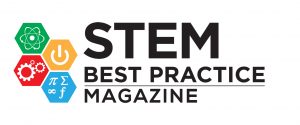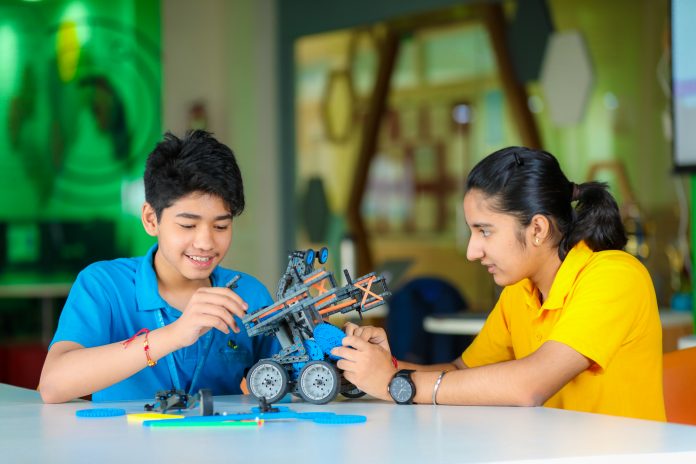About the Author
 Manisha Kathuria is a highly accomplished science educator with over 14 years of experience. She began her journey as a biology teacher and quickly progressed to leadership roles, including year lead and biology coordinator. For the past five years, she has played a pivotal role in Shiv Nadar School’s STEAM initiative, initially as a team member and now as the STEAM coordinator. Manisha fosters a dynamic, interdisciplinary learning environment, driving innovation and critical thinking through the integration of science, technology, engineering, arts, and mathematics.
Manisha Kathuria is a highly accomplished science educator with over 14 years of experience. She began her journey as a biology teacher and quickly progressed to leadership roles, including year lead and biology coordinator. For the past five years, she has played a pivotal role in Shiv Nadar School’s STEAM initiative, initially as a team member and now as the STEAM coordinator. Manisha fosters a dynamic, interdisciplinary learning environment, driving innovation and critical thinking through the integration of science, technology, engineering, arts, and mathematics.
About Shiv Nadar School
The Shiv Nadar School is a not-for-profit initiative of the Shiv Nadar Foundation in K12 private education to deliver educational excellence and provide “Education for Life”. With three campuses in the NCR and one in Chennai, Shiv Nadar School provides students with an environment that challenges them to discover their talent and skills while aiming to nurture ethical, respectful, happy, and purposeful citizens of society. 6500+ students and their parents, along with a team of around 1100+ educators, are a part of the Shiv Nadar School family.
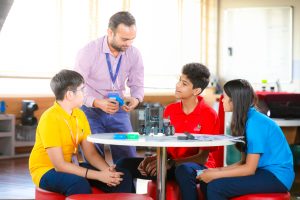 This article explores the transition from STEM (Science, Technology, Engineering, Mathematics) to STEAM (adding Arts) at Shiv Nadar School, Gurugram, India. Embracing a holistic, interdisciplinary approach, the school combines scientific rigor with creative exploration. This shift aims to equip students with the skills needed to tackle real-world challenges through critical thinking, innovation, and empathy. Key methods include project-based learning, integrated competitions, and community-driven initiatives, leading to improved problem-solving, collaboration, and sustainable solutions for global issues.
This article explores the transition from STEM (Science, Technology, Engineering, Mathematics) to STEAM (adding Arts) at Shiv Nadar School, Gurugram, India. Embracing a holistic, interdisciplinary approach, the school combines scientific rigor with creative exploration. This shift aims to equip students with the skills needed to tackle real-world challenges through critical thinking, innovation, and empathy. Key methods include project-based learning, integrated competitions, and community-driven initiatives, leading to improved problem-solving, collaboration, and sustainable solutions for global issues.
In an increasingly complex and interconnected world, the demand for innovative and adaptable thinkers has never been greater. Traditionally, STEM education focused on technical skills; however, Shiv Nadar School recognized the necessity of a more comprehensive approach that incorporates creativity, empathy, and the Arts. This evolution aims to cultivate a broader set of competencies, merging scientific inquiry with artistic exploration to develop innovative, human-centered solutions. The initiative prepares students for 21st-century challenges by emphasizing interdisciplinary learning, creative problem-solving, and real-world applications.
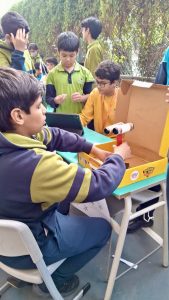
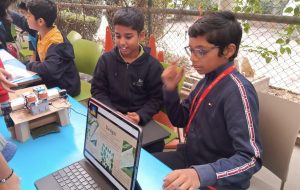
STEM education has long been the cornerstone of analytical thinking and technical proficiency. However, contemporary global challenges demand more than just technical expertise; they require creativity, empathy, and collaboration to develop sustainable solutions. The shift to STEAM at Shiv Nadar School reflects this understanding, integrating the Arts to bridge the divide between scientific thinking and creative innovation. This transformation was further catalyzed by the COVID-19 pandemic, which underscored the need for adaptable, creative problem-solvers. Inspired by a Renaissance theme, the school adopted a humanistic educational approach, linking historical innovations to modern-day issues, ultimately enriching the learning experience and fostering a culture of innovation.
Project-Based Learning:
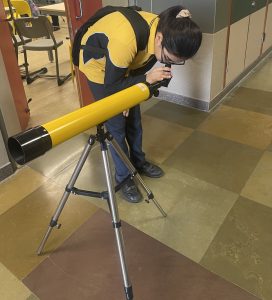 Throughout the year, students engaged in STEAM periods themed “Renaissance: Past, Present, and Future.” Drawing inspiration from historical innovations, they sought solutions to contemporary problems by reimagining futuristic telescopes, printers, sports equipment, jerseys, dance costumes, educational websites, fusion recipes inspired by the Renaissance, musical instruments, and even subtle burning solutions. Their creative endeavors culminated in various presentations, including models, radio shows, TED talks, nukkad natak, and engaging discussions, showcasing their work and highlighting the integration of historical insights with a forward-thinking mindset. The curriculum incorporated hands-on STEAM projects, immersing students in the practical application of scientific and artistic principles. Notable examples include the “telescope-making activity,” where students, guided by IUCAA, constructed 3-inch Galilean refractors to explore optics and astronomy. Additionally, the eco-builders challenge prompted students to create futuristic city models using recycled materials, emphasizing sustainable design.
Throughout the year, students engaged in STEAM periods themed “Renaissance: Past, Present, and Future.” Drawing inspiration from historical innovations, they sought solutions to contemporary problems by reimagining futuristic telescopes, printers, sports equipment, jerseys, dance costumes, educational websites, fusion recipes inspired by the Renaissance, musical instruments, and even subtle burning solutions. Their creative endeavors culminated in various presentations, including models, radio shows, TED talks, nukkad natak, and engaging discussions, showcasing their work and highlighting the integration of historical insights with a forward-thinking mindset. The curriculum incorporated hands-on STEAM projects, immersing students in the practical application of scientific and artistic principles. Notable examples include the “telescope-making activity,” where students, guided by IUCAA, constructed 3-inch Galilean refractors to explore optics and astronomy. Additionally, the eco-builders challenge prompted students to create futuristic city models using recycled materials, emphasizing sustainable design.
Competitions & Interdisciplinary Challenges
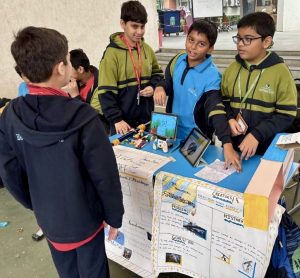 SCIENSATION, an inter-school STEAM event, encouraged students to create interdisciplinary solutions. Events such as the STOP SPECTRA stop-motion competition and the RAP Battles on Science or Math topics fostered creative expression while reinforcing scientific concepts. The Design Challenge asked students to propose solutions related to Sustainable Development Goals (SDGs), blending engineering with creativity.
SCIENSATION, an inter-school STEAM event, encouraged students to create interdisciplinary solutions. Events such as the STOP SPECTRA stop-motion competition and the RAP Battles on Science or Math topics fostered creative expression while reinforcing scientific concepts. The Design Challenge asked students to propose solutions related to Sustainable Development Goals (SDGs), blending engineering with creativity.
Paper presentation:
ELENCHUS ON RENAISSANCE: Students presented papers addressing how Modern Science justifies its superior understanding of nature compared to the myths of theology, philosophy, or poetry, fostering critical analysis of the Renaissance’s impact on scientific inquiry and the evolving nature of knowledge.
Community Engagement:
Projects like Project Urja aimed to promote energy efficiency. Led by student Arya Jha, the initiative involved energy consumption audits at Shiv Nadar School and students’ homes, identifying areas where energy usage could be reduced. This hands-on approach engaged students in environmental sustainability and demonstrated real-world application of their learning.
Guest Lectures and Panels:
 The STEAM Conclave featured thought leaders such as William Kamkwamba, author of The Boy Who Harnessed the Wind, and industry experts like Ms. Neeti Wahi and Mr. Rahul Kale, who discussed strategies to harness community engagement for global impact. These interactions allowed students to connect theory with real-world applications.
The STEAM Conclave featured thought leaders such as William Kamkwamba, author of The Boy Who Harnessed the Wind, and industry experts like Ms. Neeti Wahi and Mr. Rahul Kale, who discussed strategies to harness community engagement for global impact. These interactions allowed students to connect theory with real-world applications.
Deliverables and Prototypes
Shiv Nadar School’s STEAM initiatives were dynamic and innovative, merging scientific inquiry with creative expression. Notably, students developed prototypes focused on sustainability, such as energy-saving solutions, and built custom telescopes. The “Project Urja” energy audit was a standout effort, where students analyzed energy consumption on campus and in their homes. Their findings led to tangible recommendations for reducing energy usage, underscoring the real-world impact of their work.
The “Eco-Builders Challenge”saw students create sustainable city models using eco-friendly architecture, which emphasized reducing energy consumption. The challenge integrated both environmental science and creative design, encouraging students to envision the future of urban sustainability.
Another impressive example was the “STOP SPECTRA” competition, where students utilized stop-motion animation to visually explain complex scientific concepts, blending technology with storytelling. This competition not only highlighted students’ technical abilities but also fostered their communication and creative skills. Furthermore, interdisciplinary projects like “RAP Battles” gave students a platform to express mathematical concepts through creative performance, enhancing their engagement with the subject matter. These activities collectively demonstrated an improved capacity for critical thinking, creativity, and collaboration, revealing the practical benefits of STEAM learning in tackling real-world problems.
The way forward
At Shiv Nadar School, the ICAN mindset—Action, Collaboration, Adaptability, and Nurture—has been a focal point this academic year, designed to equip students for a fast-evolving world. Anchored by the FIDS framework—Feel, Imagine, Do, Share—this initiative empowers students to empathize with real-world challenges, imagine innovative solutions, and take meaningful action. The process emphasizes the development of design and innovation skills, encouraging students to create real-life solutions through the integration of creativity and technical knowledge.
Students apply this mindset across various domains, from environmental sustainability to social justice, often leveraging design thinking, artistic creativity, and cognitive creativity to prototype and refine their ideas. This iterative process channels creativity into practical innovations. Meanwhile, teachers receive ongoing training to cultivate educational environments that foster empathy, collaborative creativity, and cognitive creativity, ensuring that students are well-prepared to solve current and future challenges.
By embracing the ICAN mindset, Shiv Nadar School is cultivating a generation of forward-thinking leaders. These students are not only critical thinkers but also empathetic, innovative problem-solvers capable of designing and implementing impactful solutions for real-world challenges in today’s fast-paced VUCA (Volatile, Uncertain, Complex, Ambiguous) world. Through their integration of design, innovation, and creativity, they are poised to lead with vision and empathy in an unpredictable future.
The shift from STEM to STEAM at Shiv Nadar School has empowered students to approach problems through artistic creativity, collaborative creativity, and cognitive creativity, emphasizing design and innovation alongside critical thinking and technical skills. By integrating the Arts with Science, Technology, Engineering, and Mathematics, the school nurtures learners who are not only technically proficient but also empathetic and capable of developing human-centered solutions for complex real-world challenges.
Artistic creativity encourages students to express themselves through mediums such as design, music, and storytelling. Collaborative creativity promotes teamwork, where students pool their ideas to innovate and solve problems collectively. Cognitive creativity sharpens critical thinking and problem-solving abilities, helping students analyze and refine solutions. By fostering empathy, Shiv Nadar School enables students todeeply understand societal and environmental challenges, informing their design and innovation efforts. Through regular self-reflection, students critically assess their learning journey, recognize areas for growth, and strengthen their creative and cognitive skills. In a fast-paced, VUCA (Volatile, Uncertain, Complex, Ambiguous) world, this interdisciplinary approach nurtures well-rounded individuals who excel academically and are driven to create meaningful, real-world impact. The STEAM framework equips students to thrive as empathetic, reflective, creative, and innovative leaders, capable of navigating and transforming an interconnected, ever-evolving global landscape.

